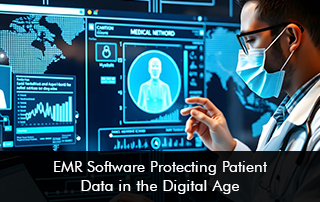EMR software has revolutionized healthcare. Unlike paper-based systems, it stores patient data digitally. With more sensitive information being handled online, there is a growing need for better protection. EMR software employs a variety of security features to prevent unauthorized access.
Key security features include:
- Encryption: Converts data into unreadable code to ensure it can’t be accessed without permission.
- User Authentication: Requires authorized users to verify their identity with passwords or biometrics.
- Audit Trails: Tracks who accessed, edited, or viewed patient information.
- Access Control: Limits access to certain users based on their roles in the healthcare organization.
With these measures, EMR systems protect patient data from security risks in the digital world.
Data Breaches Before EMR Software
Before EMR software, medical records were kept on paper. While this seems simpler, paper records have significant security flaws. Paper records could be easily misplaced, stolen, or destroyed. Even if locked in file cabinets, there was little to stop unauthorized access.
Here are some major security risks of paper medical records:
- Physical Theft: Paper records could be stolen, and the thief could access sensitive information.
- Fire and Natural Disasters: In the event of a fire, flood, or other disasters, paper records could be irretrievably lost.
- Unauthorized Access: With minimal security protocols, anyone could potentially access patient records if they had physical access to the office.
- Lack of Auditing: With paper, it’s impossible to track who accessed or copied sensitive patient information.
Examples of Data Breaches with Paper Records
Before the digital age, several data breaches occurred due to the weak security of paper records. For example, in 1996, the medical records of over 4,000 patients at a California hospital were stolen. These records were found in a public dumpster, revealing personal and medical information. This breach happened because the hospital had poor data disposal practices.
Another breach occurred in 2006 when thieves broke into a hospital in Miami and stole paper records of 6,000 patients. These records contained sensitive details like Social Security numbers and medical conditions. The paper-based system couldn’t track or control who had access to the files, leading to a significant security breach.
The Disadvantages of Weak Security in Paper Records
Weak security in the past created numerous risks for both patients and healthcare organizations. When data is compromised, patients can become victims of identity theft, medical fraud, and personal invasion of privacy. For healthcare providers, a data breach damages their reputation and can lead to legal and financial penalties.
Some key disadvantages of weak security include:
- Patient Privacy Violations: Breaches can expose private health information, violating patients’ rights to confidentiality.
- Loss of Trust: When patients feel their data isn’t secure, they may lose trust in their healthcare provider.
- Legal and Financial Consequences: Data breaches can result in lawsuits, hefty fines, and lost business.
How EMR Software Ensures Data Security
With the introduction of EMR, the healthcare industry has improved its approach to data security. Unlike paper records, EMR software employs several layers of protection to ensure patient data is safe.
EMR Software Encryption
One of the main security features of EMR software is encryption. Encryption converts patient data into unreadable code. Even if a hacker gains access to the data, they can’t read it without the decryption key. This method ensures that patient data remains confidential, even if it’s intercepted during transmission.
User Authentication
EMR systems use multi-factor authentication to verify users’ identities. This means that before a user can access the system, they need to provide more than one form of identification. For example, they may need to enter a password and scan a fingerprint. This helps ensure that only authorized users can access sensitive patient information.
Audit Trails: Tracking Every Access and Change
EMR software creates audit trails. This means it records every action taken in the system, such as who accessed the data when they accessed it, and what changes were made. Audit trails provide accountability and allow healthcare providers to monitor for any suspicious activity.
Role-Based EMR Software Access Control
Not everyone in a healthcare organization needs full access to patient data. EMR systems use role-based access control to limit what different staff members can see or do. For instance, a receptionist may only be able to see basic patient information, while a doctor can access complete medical histories. This reduces the risk of data being accessed by unauthorized staff.
Data Backups
EMR software regularly backs up patient data to secure servers. In the event of a natural disaster or system failure, the backed-up data can be restored quickly. This ensures that patient information is never permanently lost, unlike paper records, which could be destroyed.
The Future of Data Security in EMR Software
As technology advances, so will the methods for protecting patient data. EMR software will continue to evolve to address emerging threats. One area of focus for the future is artificial intelligence (AI) in security. AI-powered systems can analyze patterns and detect unusual activities that may indicate a cyberattack. AI will play a major role in preventing data breaches before they happen.
Additionally, blockchain technology may enhance security by creating decentralized, tamper-proof records. With blockchain, it becomes almost impossible for unauthorized individuals to alter patient data. This technology can potentially add an extra layer of security to EMR systems.
Healthcare organizations will also likely increase the use of biometric authentication, such as iris or facial recognition. This will make it even harder for hackers to bypass security protocols.
Lastly, government regulations around healthcare data security are expected to grow stricter. As a result, healthcare providers must stay updated on compliance requirements to ensure patient data remains secure.








